Lecture 9 - Social Development
1/88
There's no tags or description
Looks like no tags are added yet.
Name | Mastery | Learn | Test | Matching | Spaced |
|---|
No study sessions yet.
89 Terms
What is Erikson’s 1st stage of Psychosocial development?
Primary task/conflict of Babies (0-1,5 years) is Trust vs. Distrust.
There is a strong dependency on parents.
What does the child gain in Infancy when the caretaker is reliable and responsive?
Trust
What does the child gain in Infancy when the caretaker is insecure and unreliable?
Can lead to distrust (insecure attachment).
What is Attachment and its importance?
Strong emotional bond between caregiver (parents) and child (or any two people).
Attachment can influence relationships throughout life.
What does the debate of Nature vs. Nurture entail?
Nature: The way you were born.
e.g. genes and hereditary factors
Nurture: The way you were raised.
e.g. childhood experiences, surrounding culture
How does Attachment form according to the Nature view?
According to ethologists (Lorenz), forerunners of
today’s evolutionary psychologists, attachment
is a:
... biologically programmed response taking place early after birth (if attachment figure present)
... But also remember: influence of stimulus from environment (boots)
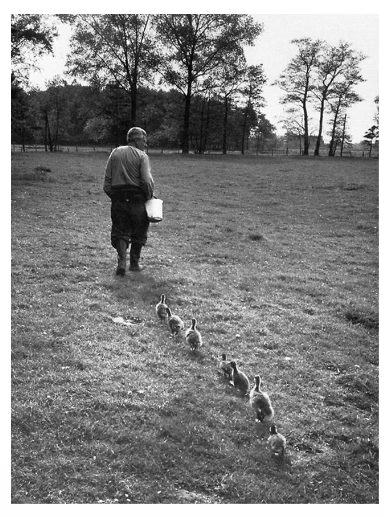
How does Attachment form according to the Nurture view?
• According to behaviorists, attachment is caused by association with food (maternal reinforcement stimulus)
If the caregiver provides food for the baby, the child will learn to attach itself to the caregiver.
What is the Behaviorist’s view on Attachment? What is the parental advice given from this view?
• Watson: Baby/child must be treated like a small adult, so they will turn out to be independent adults
Parental advice: keep emotional distance
• Behaviorism still influences our everyday thinking about upbringing
What is Watson’s parental advice?
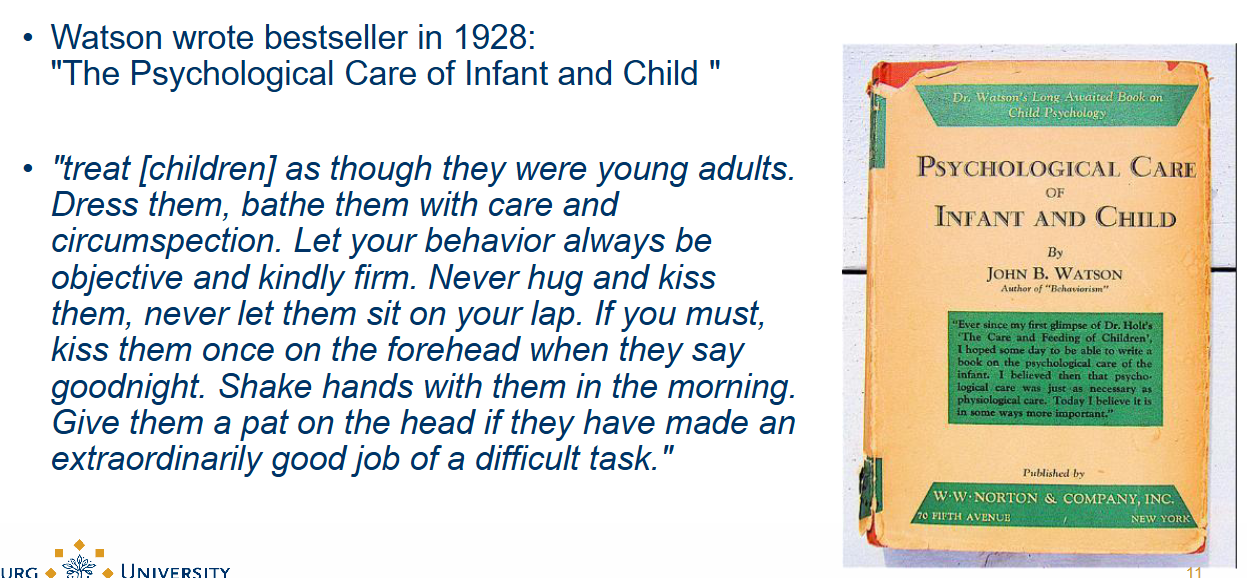

1st answer option.
What did Harlow’s experiment about Attachment entail?
He wanted to research how babies get attached.
What is more important: Food or Love?
Ethically difficult to test in humans, so:
Experiment with newborn monkeys:
A. Wire mother with milk
B. Soft, warm artificial mother without milk
Which mother did the monkeys prefer?
Short-term effects:
▪ Most monkey stayed on warm mother, but do take a drink from metal mother when necessary
▪ When scary stimulus in cage: monkey would go to warm mother → monkey got attached to warm mother
▪ Proximity-seeking behavior occurs with survival threat
Long-term effects:
▪ Monkeys who grew up “motherless” showed deviant social behavior in later life (no sexual behavior, fear of peers, no caring behavior for offspring)
→ Warm relationship of infant with parents (secure base) is crucial for development!

What were the Short-term effects of Harlow’s experiment about Attachment?
▪ Most monkey stayed on warm mother, but do take a drink from metal mother when necessary
▪ When scary stimulus in cage: monkey would go to warm mother → monkey got attached to warm mother
▪ Proximity-seeking behavior occurs with survival threat
What were the Long-term effects of Harlow’s experiment about Attachment?
▪ Monkeys who grew up “motherless” showed deviant social behavior in later life (no sexual behavior, fear of peers, no caring behavior for offspring)
What is the most important finding of Harlow’s experiment about Attachment?
Warm relationship of infant with parents (secure base) is crucial for development!
What did Bowlby say about maternal love?
"Maternal love in childhood is as important for mental health as vitamins and protein are for physical health."
What are the Nature vs. Nurture views on Bowlby’s Attachment theory?
Nature:
▪ Inborn tendency to attach to primary caretakers
▪ Critical period for attachment response
▪ But: Proximity-seeking behavior when feeling threatened at any age
Nurture:
▪ Primary caretakers influence the child’s development
There is an interaction between Nature and Nurture.
What are the Milestones of Bowlby’s Attachment theory?
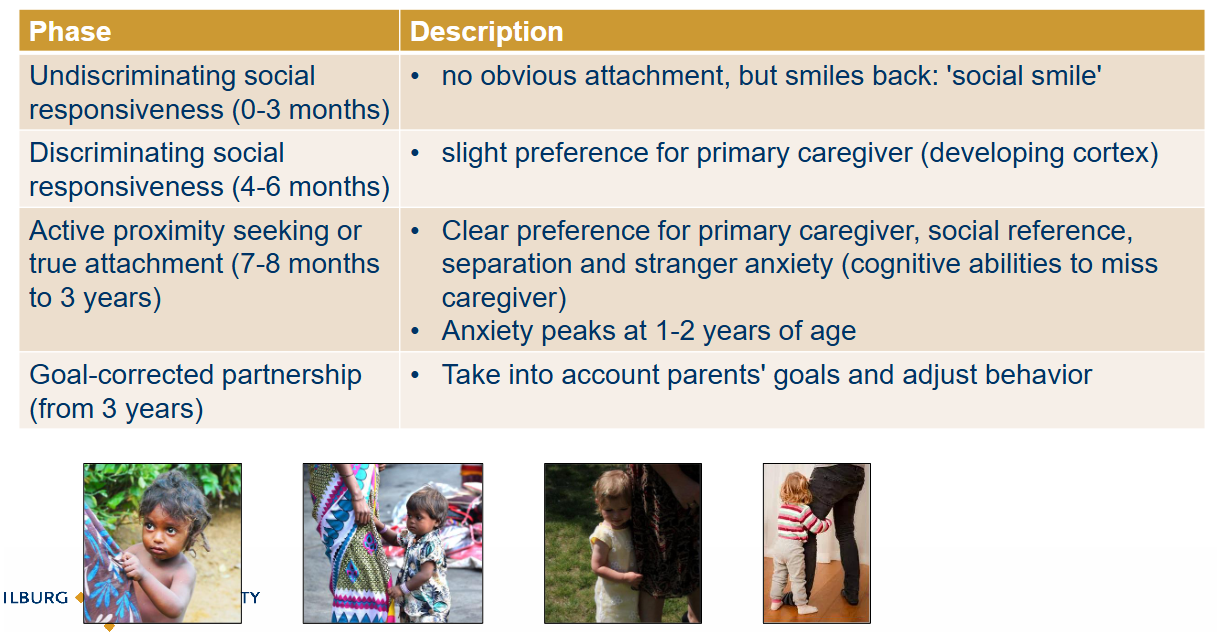
What phase is the child in at 0-3 months of Bowlby’s Attachment theory? What is the description of this phase?
Undiscriminating social responsiveness.
No obvious attachment, but smiles back: ‘social smile’.
What phase is the child in at 4-6 months of Bowlby’s Attachment theory? What is the description of this phase?
Discriminating social responsiveness.
Slight preference for primary caregiver (developing cortex; can distinguish between people).
What phase is the child in at 7-8 months to 3 years of Bowlby’s Attachment theory? What is the description of this phase?
Active proximity seeking or true attachment.
Clear preference for primary caregiver, social reference, separation and stranger anxiety (cognitive abilities to miss caregiver).
Anxiety peaks at 1-2 years of age.
What phase is the child in at from 3 years of Bowlby’s Attachment theory? What is the description of this phase?
Goal-corrected partnership.
Take into account parents’ goals and adjust behavior.
At what age does social smile but no obvious attachment show? What is the corresponding phase?
0-3 months.
Undiscriminating social responsiveness.
At what age does a slight preference for the primary caregiver develop? What is the corresponding phase?
4-6 months.
Discriminating social responsiveness.
At what age does a clear preference for a primary caregiver, social reference, separation and stranger anxiety show? What is the corresponding phase?
7-8 months.
Active proximity seeking or true attachment.
At what age does Anxiety peak?
1-2 years.
At what age do children learn to take into account parents’ goals and adjust their behavior? What is the corresponding phase?
From 3 years.
Goal-corrected partnership.
When does Sensitive period for attachment unfold?
In most vulnerable time in life, in the same period that a baby becomes mobile.
Fear bias kicks in when we “move into the world”.
What are the 2 things an Attachment figure provides?
Secure base from which to explore world.
Safe haven to return to for comfort in case of danger.
What is the Evolutionary explanation for Attachment?
Attachment is good for survival.
What is the importance of Relationships with primary caretaker?
Relationship with primary caregiver forms basis for future relationships.
What does the Strange situation experiment by Mary Ainsworth entail?
Method to examine children’s attachment style
1. Mother and child play together
2. Stranger enters room (picture)
3. Mother leaves room (alone w stranger)
4. Mother returns, stranger leaves
5. Mother leaves (child alone)
6. Stranger returns
7. Mother returns
How does the child respond to leaving, stranger, the reunion?
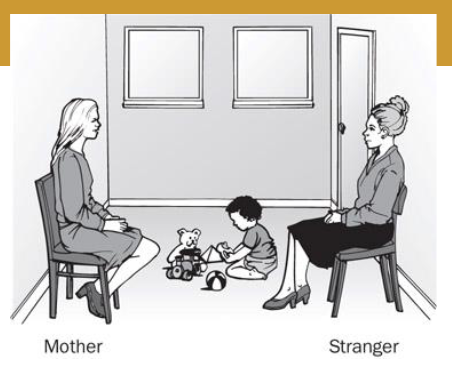
What are the 2 responses in the Strange situation (Ainsworth) that babies show when the parent returns?
Secured attachment
▪ Child responds happily to parent or can easily be comforted by the parent
▪ Parent is a safe base from which the child can explore the surroundings
Insecure attachment
▪ Child does not respond happily and cannot be comforted by the parent
▪ Parent is not a safe base
What are the 3 types of Insecure attachment styles that came forth of the Strange situation by Ainsworth?
Avoidant: shows no separation anxiety and shows little emotion as the parent returns
Resistant/Ambivalent: much anxiety and stress after separation, ambivalent (e.g., sad and angry) emotions when parent returns, inconsolable by parent
Disorganized/disoriented: no consistent way of coping, confused (frozen) or contradictory behavior, deviant response to return of parent (e.g., fear, running away)
What are Internal working models?
Cognitive representations of self and others.
Important for processing social information and behavior in relationships.
Attachment experiences affect internal working models.
How can Internal working models be affected by Attachment experiences?
Safely attached children
Positive internal working models
"I am lovable and can trust others"
Insecurely attached children
Negative internal working models
“I am difficult to love me and I can't trust others"
How does a child get securely attached? Give 3 conditions needed.
1. Sensitive parenting: sensitivity to a baby’s signals, needs, emotions
2. Intergenerational transfer: is the parent securely attached?
Attachment often mirrors caregivers’ working model of attachment
Or transfer of same ‘attachment genes’?
3. Match between children’s needs and environmental support
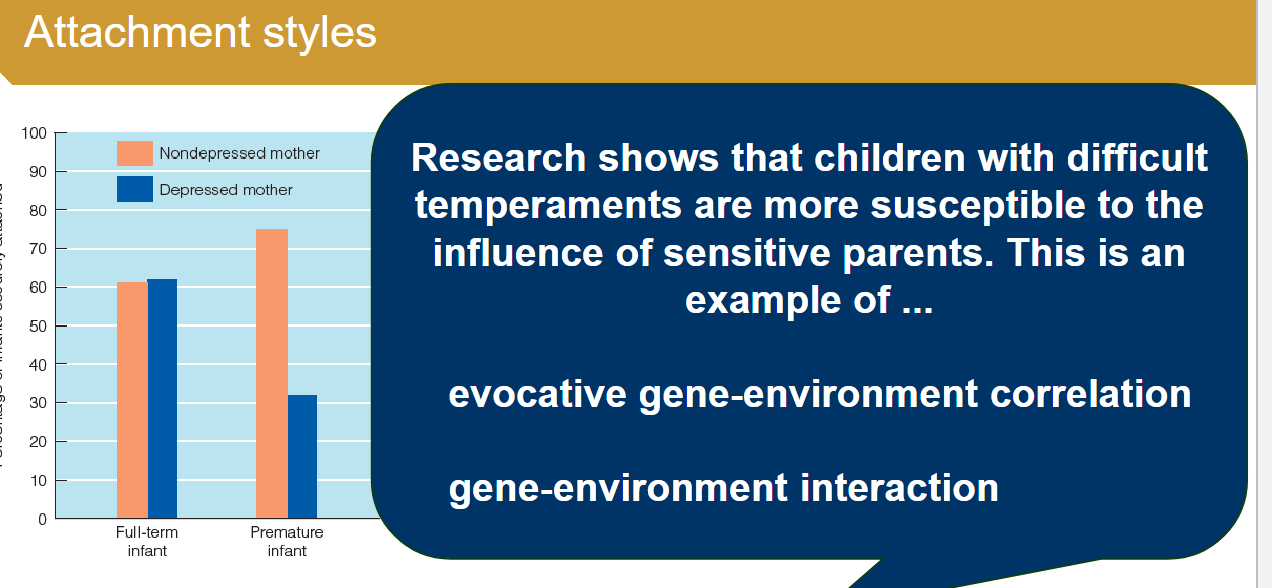
After comparing full-term infants and premature infants with mothers who are depressed or not. When the child was born early, there is a big difference for mothers that did not suffer from depression, these children were more categorized as secure attachment.
Gene-environment interaction.
Interaction that we have between the preconditions of the mothers and the genes of the child??
How does attachment develop over time?
▪ Stable environment: same attachment style over time
▪ Change in environment (e.g., divorce or death of parent) can lead to change in attachment style
What are the effects of secure attachment?
Securely attached kids are more likely to grow up to be
socially competent,
higher self-esteem,
higher quality friendships
What are 4 Criticisms on the Attachment styles / Strange situation?
▪ Categories of attachment may be overly simplified
▪ Children with disorganized attachment style mixed group
▪ 20 minutes not sufficient to capture full quality of relationship
▪ Cultural differences may impact results
Is infant attachment universal?
YES; Attachment to primary caregiver is universal; multiple relationships possible.
▪ Worldwide, similar percentage of babies (60-70%) are securely attached
▪ But: Some cultural differences
E.g., in Japan infants more likely to be distressed (uncommon for mother and child to separate)
E.g., in Germany more insecure-avoidant behavior (stronger focus on fostering independence in children
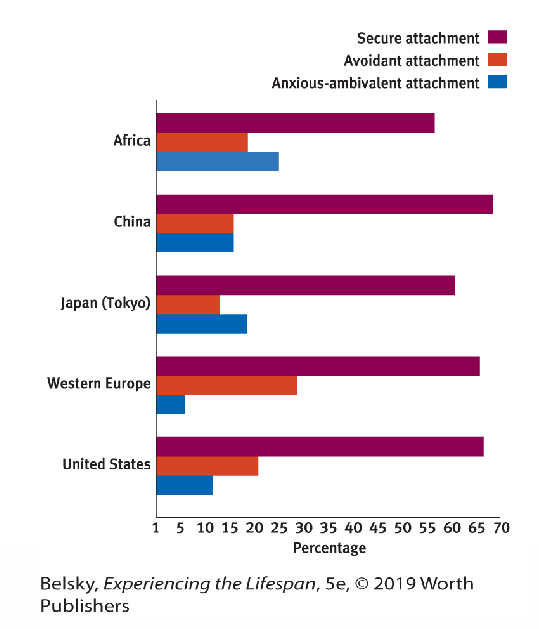
What are the effects of Early life deprivation on Attachment?
Impact of severe deprivation and emotional (and physical) neglect in early childhood?
Romanian orphanages (‘90)
Secure attachment still possible, but timing (and severity of deprivation and neglect) is crucial!
▪ Adopted prior/at 20 months: 60% secure
▪ Adopted 24 months: 30% secure
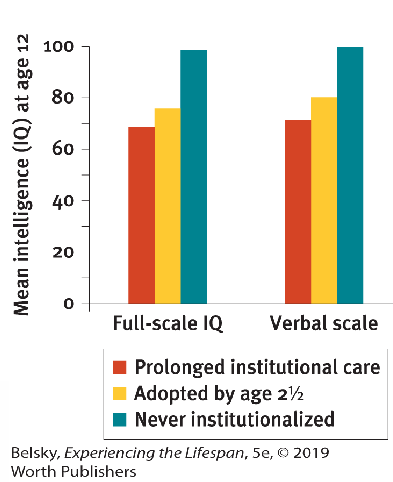
Does daycare have a (negative) effect on child’s attachment to parents?
NO (according to US American studies)
▪ It depends on the daycare (vast variability in US):
Quality of daycare determine impact more than number of hours
Low child-to-caregiver ratios and care-provider stability
Caregiver–child attachment key to quality care
Predictable routine and daily structure
What is the importance of Play?
Play is the main activity in early childhood → Important influence on cognitive skills.
What are the 4 types of Play?
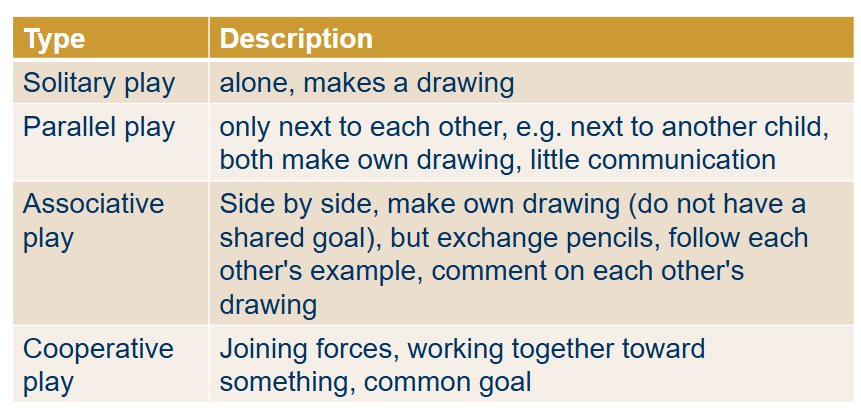
What is Solitary play?
Alone, makes a drawing.
What is Parallel play?
Only next to each other, e.g. next to another child, both make own drawing, little communication
What is Associative play?
Side by side, make own drawing (do not have a shared goal), but exchange pencils, follow each other's example, comment on each other's drawing.
What is Cooperative play?
Joining forces, working together toward something, common goal.
Ben and Anna are both in the sandbox. Ben is building a sand castle while Anna is digging a hole. The two children do not talk to each other.
What type of play is this?
Parallel play.
Nina and Mary are both at the drawing table. Nina calls Mary to show her drawing and gives Mary her pencil so Mary can also draw an elephant. Mary compliments Nina’s drawing and gets started with her own drawing.
What type of play is this?
Associative play.
Rick and Koen are building a lego tower together, in which Rick gives Koen the lego blocks and Koen is putting them on top of each other.
What type of play is this?
Cooperative play.
What are the 2 major changes in play between infancy and age 5?
More social
More imaginative
Beginning pretending
Emerges in later infancy (e.g., baking in kitchen)
Collaborative pretend play
Starts around age 4,
Involves fantasizing together with other play partner
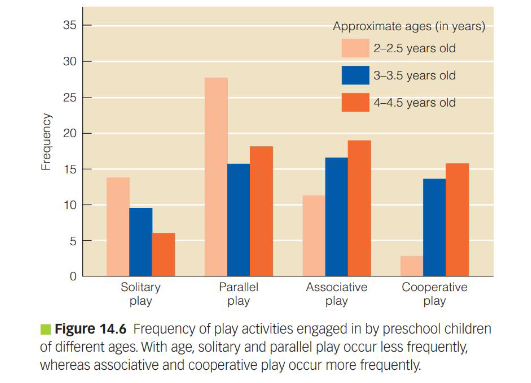
What change in play can be seen after age 5 or so?
After age 5 or so, change to somewhat more serious, rule- governed and skill-building play (pretend play less frequent).
What are the 5 functions of play?
Play allows children to develop and practive many skills.
Motor (physical or locomotor play → associated with neural maturation and refinement of motor skills)
Cognition (pretend play → better performance on tests of cognitive development, executive function, and creativity)
also in inverted directions; those with higher cognition can play more imaginary.
Language (pretend play → language skills)
division of rules, discussion fosters language skills.
Social (social pretend play → children’s understanding of others’ perspectives, social skills and popularity)
popularity can be traced back to more social pretend play.
Emotional (play → healthy emotional development by providing opportunities to act out or express bothersome feelings, regulate emotions, and resolve emotional conflicts)
What is the essence of friendship?
Similarity; in gender, age, but also values, interests, etc.
What do developmental theories say about the function of having a best friend?
• fulfills the need for self-validation and intimacy that emerges at around age 9
ex. to share secrets with each other, to take each other’s perspective → important for growing intimacy?
• serve as a training ground for adult romance
→ Protecting factor of having a friend; friends also teach emotions.
friendships can promote emotional development (teaching emotions, expressing emotions, feeling emotions, etc.).
What is the importance of Popularity in development?
Popularity becomes an absorbing question in later elementary school. Social status (being liked by others) becomes children’s primary goal
Entering concrete operations makes children highly sensitive to making social comparisons
What stage of Piaget’s cognitive development make children highly sensitive to making social comparisons?
Entering concrete operations.
What is an example of social comparison?
Comparing social statuses, f.e. he has 7 friends while I only have 2; he is my best friend but I am not his.
What are 4 things that Popularity is related to?
Physical attractiveness
Intelligence
Social competence
Emotion regulation abilities
How is popularity measured?
Sociometric status.
What is Sociometric status?
In class: peer nominations.
Based on “liked most” and “liked least” nominations.

What are the 2 outcome measures of Sociometric status?
1) Continuous outcome measure:
Social preference score = acceptance minus rejection
difference between the amount of times they were accepted minus the amount of times they were rejected → see who is most accepted and most popular.
2) Categorical outcome measure:
• Popular (high pos/low neg) 11%
• Rejected (low pos/high neg) 13%
• Neglected (low pos/low neg) 9%
• Controversial (high pos/high neg)7%
• Average (medium on both) 60%

What are the 2 different reasons for Social exclusion and peer rejection?
a) Interpersonal: individual differences, e.g., attractiveness, social deficits/temperamental characteristics (being shy or withdrawn)
b) Intergroup: bias or prejudice regarding group memberships, e.g., ethnicity, socioeconomic status, nationality, native language group, gender, culture, or religion
What are the 6 consequences of Social exclusion and peer rejection?
Same consequences:
• Lower levels of well-being
• Academic difficulties
• Decrease in prosocial behavior
• Low self-esteem
• Internalizing symptoms (e.g., depression)
• Externalizing symptoms (e.g., aggression)
Consequences can reinforce social exclusion.
What is Bullying?
Repeatedly inflicting harm through words or actions on a targeted peer.
What are the 2 forms of Bullying?
Takes many forms: physical aggression + more indirect or covert forms of aggression.
Includes cyberbullying
Not limited to childhood + adolescence, occurs also in adulthood.
What are the prevalence rates of Bullying?
26% of 11- to 15-year-olds repeatedly bully and/or are bullied at least 2-3x/month) – different rates between countries (˂10% in Scandinavian countries vs. 40% in Baltic countries)
What is the main motivation to bully?
Gaining status.
What are the consequences of Bullying?
See also consequences of social exclusion.

What are the long-term consequences of Bullying?
The more exposure to bullying, the higher levels of inflammation markers (CRP).
Pure bullies have significantly lower levels of CRP and proves to be succesful in gaining status.
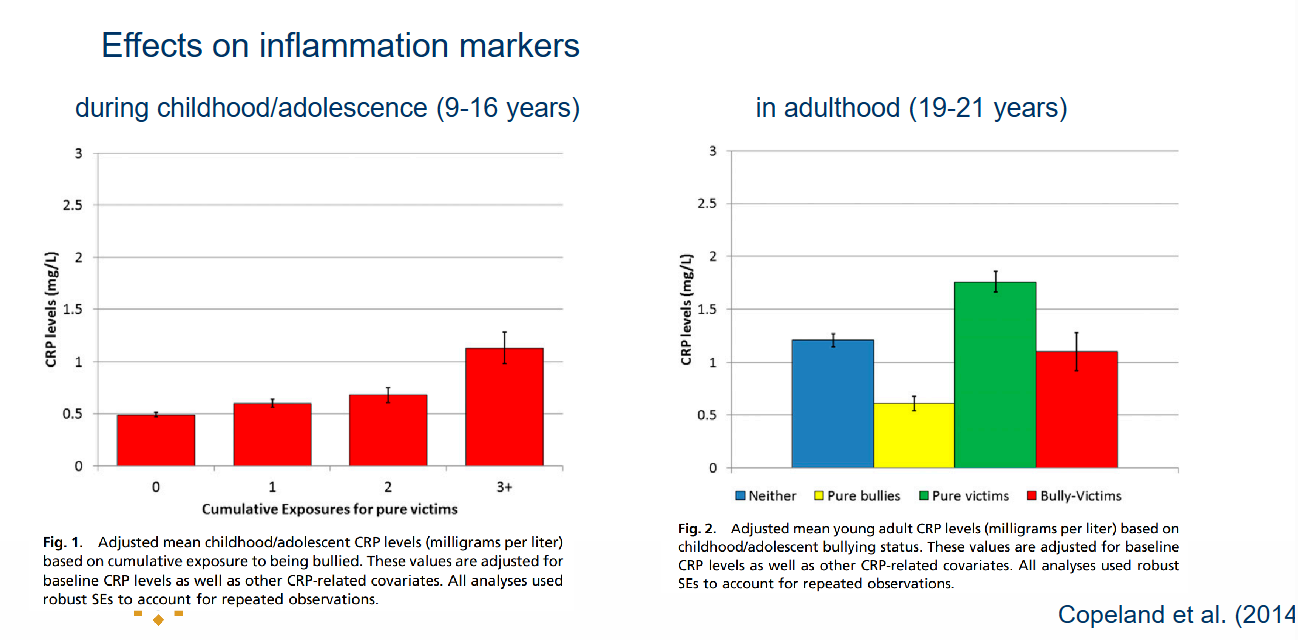
What are 2 types of interventions of Bullying?
1. Social skill trainings for victims or children at risk for rejection and exclusion (learn to stand up for themselves)
Mixed results or no positive outcomes for almost half of the studies
Not efficient if bullying is based on group membership and not social deficits
this intervention assumes that this person has social deficits, but this is not always the case — bullying could also happen based on group membership.
2. Antibullying programs in schools: combat bullying and encourage students to report or intervene in bullying incidents rather than reinforcing bullies
E.g., Olweus Bullying Prevention Program: focusing on school as a whole, the class, the individual, and the broader community → successful in reducing bullying and changing attitudes toward it
Fostering inclusive school environments by encouraging bystander behaviors and by reinforcing school and peer group norms that promote inclusivity
What does the Olweus Bullying Prevention Program entail?
Focusing on school as a whole, the class, the individual, and the broader community → successful in reducing bullying and changing attitudes toward it.
What are the changes in social life in Adolescence?
From parents to peers; Peers surpass parents as sources of intimacy and support. → Change of internal working models for attachments to parents and close friends/partner
• Supportive parents provide security and encouragement to become independent and autonomous
→ Balance of exploration and attachment
• Secure attachment during adolescence:
sense of identity, self-esteem
social skills
emotional adjustment, fewer behavioral problems
attachment to friends and later to romantic partners
What is the importance of having Supportive parents in adolescence?
They can provide security and encouragement to become independent and autonomous.
Balance of exploration and attachment.
What does Secure attachment in adolescence lead to?
sense of identity, self-esteem
social skills
emotional adjustment, fewer behavioral problems
attachment to friends and later to romantic partners
Adolescents find friendships with peers who are similar in what 3 things?
physical characteristics (e.g., age, gender, cultural background)
behavior (e.g., academic motivation, hobbies)
psychological qualities (e.g., interests, attitudes, values, and personalities)
Increasingly cross-sex friendships, but attain high level of intimacy only during later adolescence
Adolescents connect in groups, what are the 4 types of groups and the corresponding developmental life stage?
At entry to middle school = Unisex cliques
Late middle school / early high school = Crowds
High school = Mixed-sex cliques
Emerging adulthood = Romantic partners

What are the 3 stages of Dating in adolescence?
1. Entry into romantic attractions and affiliations (11 to 13 years)
Triggered by puberty → interest in romance, dominates conversations
Developing a crush on someone, crush often shared with a same-sex friend, but not necessarily interaction: If dating, then usually in a group setting
2. Exploring romantic relationships (14 to 16 years)
Both casual dating and group dating
3. Consolidating dyadic romantic bonds (17 to 19 years)
More serious romantic relationships develop →strong emotional bonds, more closely resembling those in adult romantic relationships, more stable and enduring
What are the studies done on Peer influence?
How easy is it to influence adolescents?
• Standard hypothesis: Power of influence increases during early adolescence, decreases in late adolescence (curvilinear)
• Steinberg & Monahan hypothesis (2007): Power of influence decreases linearly during adolescence
What does the Questionnaire study on Peer influence entail?
1) Questionnaire study:
• Tested by using resistance to peer influence scale
• Example item:
„Some people go along with their friends just to keep their friends
happy“ vs. „Other people refuse to go along with what their friends
want to do, even though they know it will make their friends unhappy“
Result (in 3 large samples): Power of influence decreases linearly between age 14 and 18 years (resistance increases).
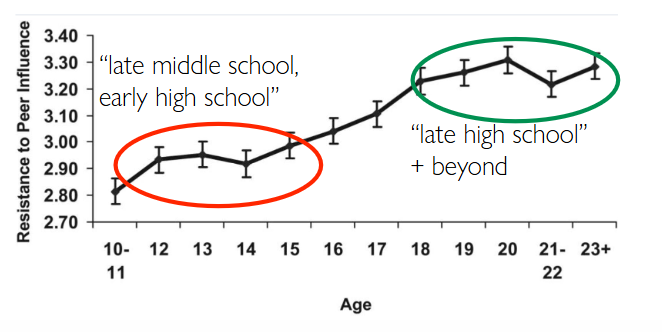
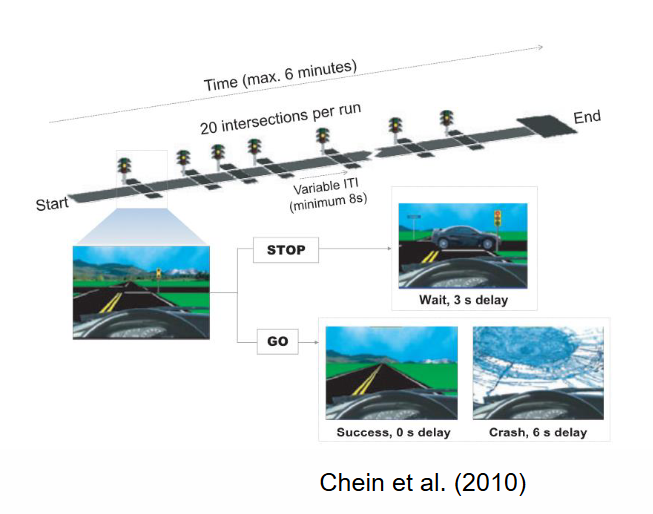
What does the Experimental study on Peer influence entail?
Simulated driving task in the lab
• Group: adolescents, young adults and older adults
• Condition: alone vs. with peer\
Results:
Adolescents make riskier decisions in front of their peers
Not so with adults
→ Peer influence decreases
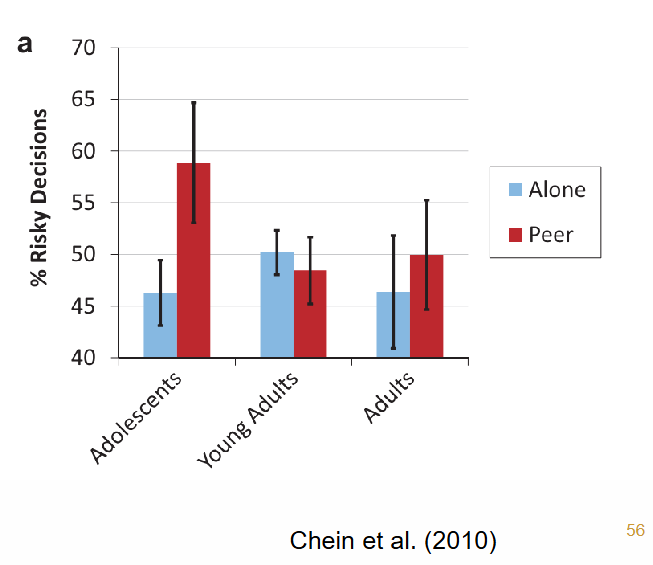
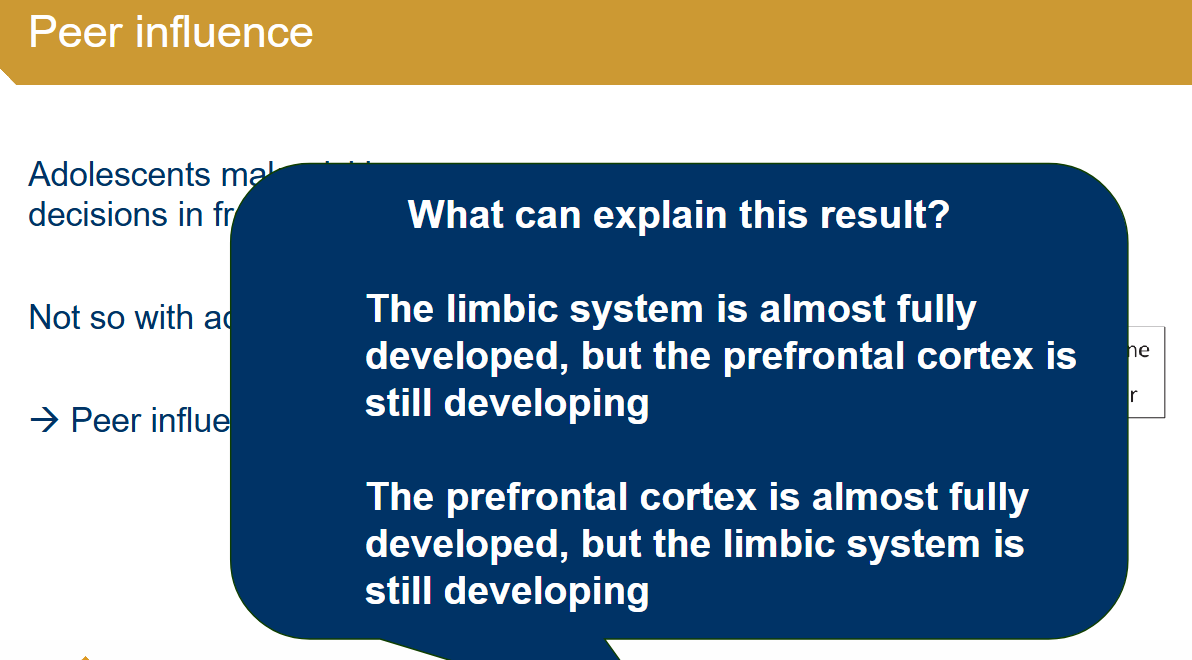
What is the correlation between decision making and peer influence?
Adolescents make riskier decisions when they are with their peers
• Research suggests that being with peers has enormous effect on young teens, e.g., binge drinking
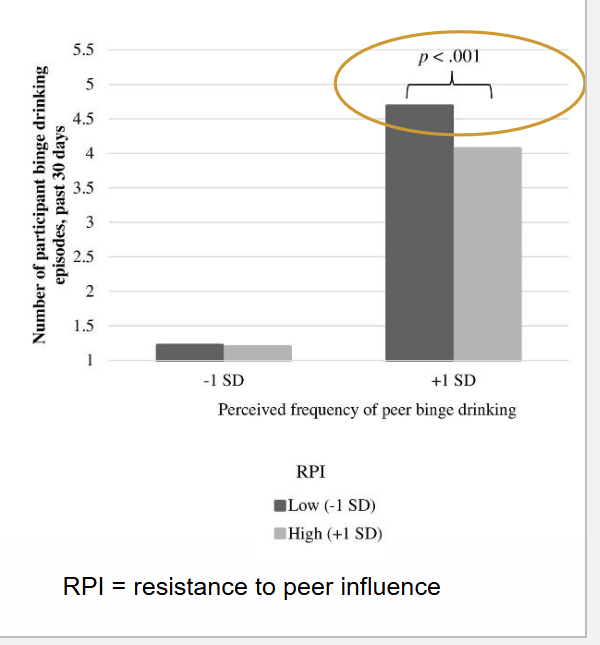
Results Meta-analysis Rutgers et al (2004) on Attachment and Autism spectrum disorder
One meta-analysis (Rutgers et al., 2004): based on four samples → 53% of children with ASD securely attached → children with autism significantly less securely attached to their parents than comparison children (moderate effect size)
Effect moderated by mental development: no difference to controls for ASD children with higher mental development and less severe ASD symptoms
Systematic review of Teague et al (2017) on Attachment and Autism spectrum disorder
47% of children with ASD securely attached→ Children with ASD can form secure attachments, security of attachment does not differ from TD controls
When are insecure attachments more likely to happen in children with autism spectrum disorder? 4 reasons
• ASD + intellectual disability/developmental delay
• Greater severity of autism symptoms
• Poorer parent-child interaction
• Fewer pro-social responses to caregivers (difficulties in social-communication experienced by children with ASD pose a challenge for caregivers to tune-in to their child’s subjective state, and for children to understand and predict caregiver’s behaviour)
Neurobiological studies on Attachment and Autism spectrum disorder
Comparable to children without ASD, significant increases in cortisol during stressful separation episodes and increases in oxytocin during interactions with caregivers in children with ASD
→ despite lower hormone levels at baseline, children experience similar hormonal changes linked to separation and reunion